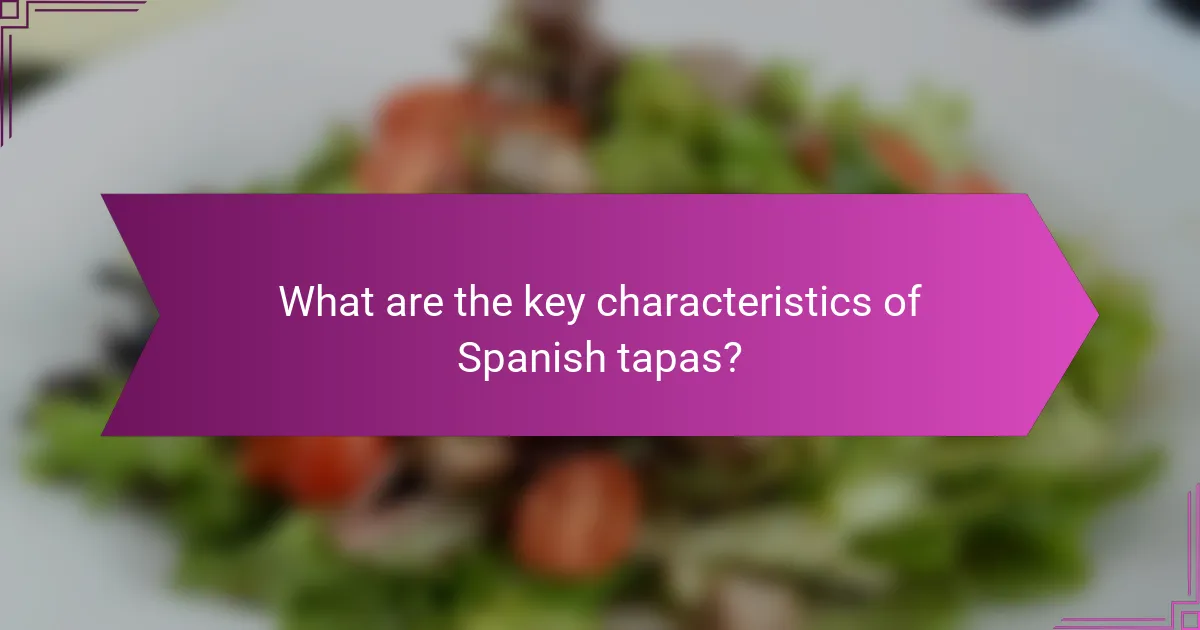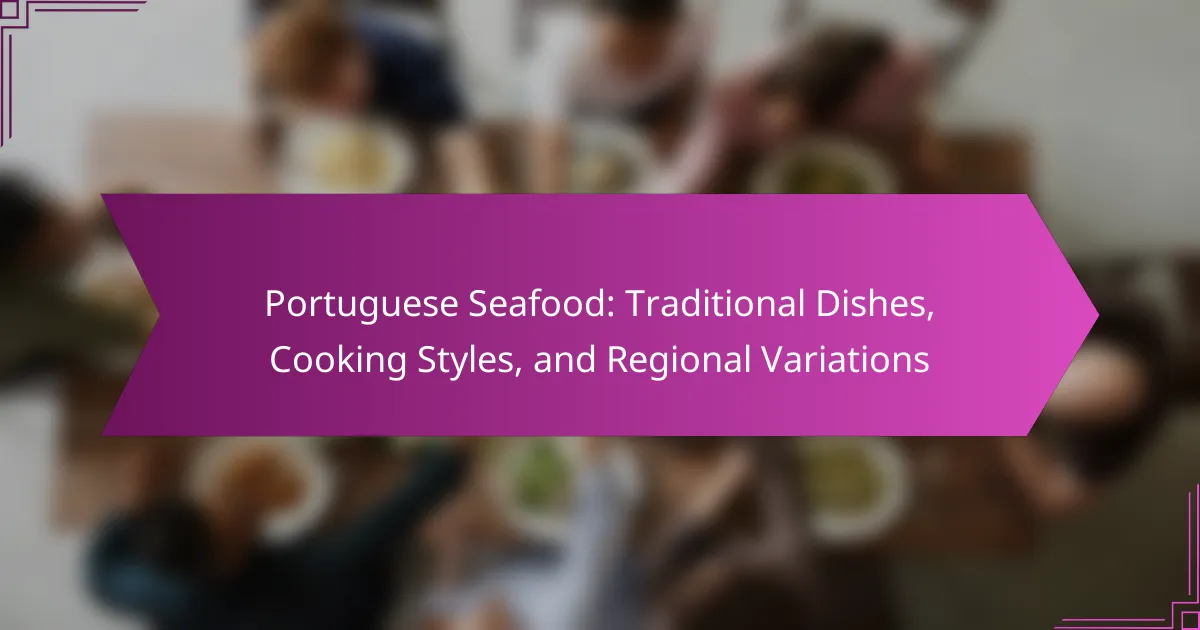Spanish tapas offer a delightful way to explore diverse flavors while fostering social connections. This article covers popular dishes like patatas bravas and gambas al ajillo, common preparation methods such as frying and grilling, and the unique cultural contexts in which tapas are enjoyed. Discover how to create an authentic tapas experience at home, emphasizing variety and presentation.

What are the key characteristics of Spanish tapas?
Spanish tapas are characterized by their small portions, diverse ingredients, and communal dining style. These dishes often include a variety of flavors and textures, showcasing regional specialties. Common preparation methods involve grilling, frying, or marinating, enhancing the taste and presentation. The social context emphasizes shared experiences, making tapas a popular choice for gatherings.
How do tapas vary across different regions of Spain?
Tapas vary significantly across different regions of Spain, reflecting local ingredients and culinary traditions. For instance, in Andalusia, cold tapas like gazpacho and marinated fish are popular, while in Catalonia, you might find escalivada, a dish of roasted vegetables. In the Basque Country, pintxos, small snacks served on skewers, dominate the scene. Each region showcases unique flavors and preparation methods, emphasizing local produce and cultural influences.
What are the cultural significance and social context of sharing tapas?
Sharing tapas holds significant cultural and social importance in Spain, fostering community and connection. This practice encourages socializing, as people gather to enjoy various small dishes together. Tapas embody the essence of Spanish cuisine, emphasizing fresh ingredients and regional flavors.
The communal aspect of sharing tapas promotes conversation and interaction, making meals more enjoyable. Traditionally, tapas are enjoyed in bars or at home, creating a relaxed atmosphere. This social context enhances the dining experience, transforming it into a cultural ritual.
Moreover, the variety of tapas reflects Spain’s diverse culinary heritage. Each region offers unique dishes, showcasing local ingredients and traditions. This diversity not only enriches the dining experience but also strengthens cultural identity.
Ultimately, sharing tapas is more than just a meal; it represents a way of life in Spain, emphasizing togetherness and appreciation for food.

Which popular tapas dishes should you try?
You should try patatas bravas, gambas al ajillo, tortilla española, chorizo al vino, and pimientos de padrón. These dishes showcase the variety and flavors of Spanish tapas.
Patatas bravas are fried potatoes served with a spicy tomato sauce. Gambas al ajillo features shrimp cooked in garlic and olive oil, offering a rich seafood taste. Tortilla española is a traditional Spanish omelette made with potatoes and onions, providing a hearty option. Chorizo al vino consists of chorizo sausage simmered in red wine, enhancing its flavor profile. Pimientos de padrón are small green peppers, typically fried and sprinkled with sea salt, known for their mild heat and unique taste.
How are traditional tapas prepared and served?
Traditional tapas are prepared using fresh ingredients and often feature simple, rustic cooking methods. Common preparation techniques include grilling, frying, marinating, and baking, emphasizing flavors and textures. Tapas are typically served in small portions, encouraging sharing and social interaction among diners. This communal aspect enhances the dining experience, making it a staple of Spanish culture.
What are some contemporary twists on classic tapas recipes?
Contemporary twists on classic tapas recipes include innovative ingredients and modern techniques. For example, traditional patatas bravas can feature spicy aioli or truffle oil. Another twist is using quinoa in stuffed peppers instead of rice, enhancing nutrition. Additionally, chefs are experimenting with molecular gastronomy, creating tapas like spherified olives that burst with flavor. These adaptations maintain the essence of tapas while appealing to contemporary palates.

What preparation methods are commonly used for tapas?
Common preparation methods for tapas include frying, grilling, baking, and marinating. Each method enhances the flavors and textures of the ingredients used. For example, frying is popular for dishes like patatas bravas, while grilling is often used for skewered meats and vegetables. Baking is ideal for dishes such as tortilla española. Marinating adds depth to flavors in seafood tapas. These methods contribute to the diverse and vibrant nature of Spanish tapas.
How does the cooking technique influence the flavor of tapas?
Cooking techniques significantly influence the flavor of tapas by enhancing or altering key ingredients. Techniques such as grilling, frying, and marinating create distinct taste profiles. For instance, grilling imparts a smoky flavor, while frying adds crispiness. Marinating allows flavors to penetrate ingredients, enriching the overall dish. These methods not only affect taste but also texture, contributing to the social experience of sharing tapas. The choice of technique can elevate simple ingredients, making them more appealing and flavorful.
What ingredients are essential for authentic tapas dishes?
Essential ingredients for authentic tapas dishes include olives, chorizo, seafood, vegetables, and bread. These components reflect Spain’s diverse culinary traditions.
Olives serve as a staple, often marinated with herbs. Chorizo adds a rich, smoky flavor, while seafood like shrimp and anchovies highlight coastal influences. Fresh vegetables, such as peppers and tomatoes, provide vibrant color and taste. Bread is essential for serving with various toppings or as a base for dishes like bruschetta.
Each ingredient contributes to the social experience of sharing and enjoying tapas, making them a beloved part of Spanish culture.

How do dining customs around tapas differ in various Spanish-speaking countries?
Dining customs around tapas vary significantly across Spanish-speaking countries. In Spain, tapas are often served as small plates for sharing, fostering social interaction. In Mexico, similar dishes called “antojitos” are enjoyed, but they focus more on street food and local ingredients. In Argentina, tapas take the form of “picadas,” featuring cured meats and cheeses, emphasizing a more casual, family-oriented dining experience. Each country embraces unique ingredients and cultural influences, reflecting their culinary diversity.
What role do tapas play in social gatherings and celebrations?
Spanish tapas foster social interaction and enhance gatherings. They encourage sharing, conversation, and a relaxed atmosphere. Tapas can be tailored to suit various occasions, from casual meetups to festive celebrations. The variety of flavors and presentation stimulates engagement among guests, making them a central element in social dining experiences.
Which beverages are typically paired with tapas in different cultures?
Spanish tapas are often paired with a variety of beverages that enhance the dining experience. In Spain, traditional choices include red wine, especially Tempranillo, and dry sherry, which complement the flavors of the dishes. In the Basque Country, locals enjoy pairing tapas with Txakoli, a slightly sparkling white wine.
In Latin American cultures, such as in Mexico, beer is commonly paired with tapas-like dishes, often accompanied by lime and salt. In contrast, in Mediterranean regions, such as Italy, tapas are enjoyed with Prosecco or light red wines. These beverage pairings reflect the unique culinary traditions and social contexts of each culture, enhancing the overall enjoyment of tapas.

What are some unique tapas ingredients that elevate the dining experience?
Unique tapas ingredients that elevate the dining experience include smoked paprika, saffron, and Ibérico ham. These ingredients enhance flavor profiles and provide authenticity. Smoked paprika adds depth, saffron introduces a luxurious touch, and Ibérico ham offers rich, savory notes. Combining these ingredients in dishes like patatas bravas or gambas al ajillo transforms traditional tapas into memorable culinary experiences.
How do rare ingredients impact the authenticity of tapas?
Rare ingredients enhance the authenticity of tapas by providing unique flavors and cultural significance. These ingredients, often sourced locally or regionally, reflect traditional Spanish culinary practices. For example, the use of rare peppers like Padrón adds distinct taste profiles. Additionally, ingredients such as Iberian ham showcase regional specialties that elevate the dining experience. Authenticity is further emphasized when chefs incorporate these rare elements into their preparations, preserving the essence of Spanish gastronomy.
What are some lesser-known tapas dishes worth exploring?
Some lesser-known tapas dishes worth exploring include espinacas con garbanzos, bacalao al pil-pil, and pimientos de padrón. These dishes offer unique flavors and regional authenticity.
Espinacas con garbanzos features spinach and chickpeas, often seasoned with garlic and spices, providing a nutritious option. Bacalao al pil-pil is a cod dish prepared with olive oil and garlic, creating a rich sauce. Pimientos de padrón are small green peppers, typically fried and served with sea salt, offering a delightful mix of mild and spicy flavors.
Exploring these lesser-known tapas can enhance your culinary experience and introduce you to the diverse world of Spanish cuisine.

What are best practices for enjoying tapas at home?
To enjoy tapas at home, focus on variety, presentation, and sharing. Start with a selection of popular dishes like patatas bravas, chorizo al vino, and gambas al ajillo. Use small plates for serving, allowing guests to sample multiple flavors. Prepare dishes in advance to ease cooking stress. Create a relaxed atmosphere with music and drinks to enhance the social experience. Pair tapas with Spanish wines or sangria for an authentic touch.
How can you create a tapas-inspired menu for your next gathering?
To create a tapas-inspired menu for your next gathering, focus on a variety of small dishes that encourage sharing. Include popular Spanish tapas such as patatas bravas, chorizo al vino, and gambas al ajillo. Preparation methods vary; some dishes require simple frying or roasting, while others involve marinating or grilling. Incorporate a social context by serving with Spanish wines or sangria to enhance the communal dining experience.
What common mistakes should you avoid when preparing tapas?
To prepare tapas successfully, avoid common mistakes like overcomplicating recipes, neglecting ingredient quality, and skipping traditional techniques. Focus on simplicity, freshness, and authentic flavors.
1. Overcomplicating dishes: Stick to classic preparations to highlight key ingredients.
2. Using low-quality ingredients: Fresh, high-quality components enhance flavor.
3. Ignoring portion sizes: Tapas should be small and shareable; avoid large servings.
4. Skipping presentation: Visual appeal is important; arrange dishes attractively.
5. Not considering pairing: Complement dishes with appropriate drinks for a complete experience.



